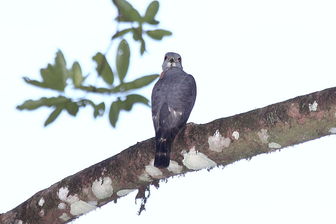Double-toothed Kite
Its natural habitats are subtropical or tropical moist lowland forests and subtropical or tropical moist montane forests.

Original source: Dominic SheronyPermission(Reusing this file)This image, which was originally posted to Flickr.com, was uploaded to Commons using Flickr upload bot on 07:43, 30 May 2011 (UTC) by DreamOfShadows (talk). On that date it was licensed under the license below. This file is licensed under the Creative Commons Attribution-Share Alike 2.0 Generic license.You are free:to share – to copy, distribute and transmit the work
Author: Dominic SheronyPermission(Reusing this file)This image, which was originally posted to Flickr.com, was uploaded to Commons using Flickr upload bot on 07:43, 30 May 2011 (UTC) by DreamOfShadows (talk). On that date it was licensed under the license below. This file is licensed under the Creative Commons Attribution-Share Alike 2.0 Generic license.You are free:to share – to copy, distribute and transmit the work
The Double-toothed Kite is classified as Least Concern. Does not qualify for a more at risk category. Widespread and abundant taxa are included in this category.
The Double-toothed Kite (Harpagus bidentatus) is a species of bird of prey in the Accipitridae family. It is found in Belize, Bolivia, Brazil, Colombia, Costa Rica, Ecuador, El Salvador, French Guiana, Guatemala, Guyana, Honduras, Mexico, Nicaragua, Panama, Peru, Suriname, Trinidad and Tobago, and Venezuela. Its natural habitats are subtropical or tropical moist lowland forests and subtropical or tropical moist montane forests. References - * BirdLife International 2004. Harpagus bidentatus. More
The Double-toothed Kite (Harpagus bidentatus) is endemic to Belize, Bolivia, Brazil, Colombia, Costa Rica, Ecuador, El Salvador, French Guiana, Guatemala, Guyana, Honduras, Mexico, Nicaragua, Panama, Peru, Suriname, Trinidad and Tobago and Venezuela. Their preferred natural habitats include the subtropical or tropical moist lowland forests and montane forests. More
Double-toothed Kite determination Similar species Accipitridae Bicolored Hawk | Black Hawk-Eagle | Black-and-White Hawk-Eagle | Black-collared Hawk | Black-faced Hawk | Crane Hawk | Crested Eagle | Double-toothed Kite | Great Black Hawk | Grey Hawk | Grey-bellied Hawk | Grey-headed Kite | Harpy Eagle | Hook-billed Kite | Long-winged Harrier | Ornate Hawk-Eagle | Osprey | Pearl Kite | Plumbeous Kite More
of a Double-toothed Kite preying on a tent-making bat (Artibeus sp.) flushed by a squirrel monkey (Saimiri oerstediï). Here, we describe the hunting and successful capture of bats by a solitary adult Double-toothed Kite. On 29 March 1996, while searching for Orange-breasted Falcons (Falco deiroleucus) in a remote area of western Pet�n, Guatemala, we observed an adult Double-toothed Kite hunting bats emerging from their cliff crevice roosts near the bottom of a large limestone sinkhole. More
Double-toothed Kite at Manuel Antonio = The double notch on the bill is apparent in this picture Hawks Costa Rica main Birds main More
Double-toothed Kite, Peru, Manu Road 12/08/2006 © Mark Sutton Send this as a postcard Double-toothed Kite - Double-toothed Kite, Colombia, Antioquia 03/12/2007 © Carl Downing Birding Colombia - Bird Tours Send this as a postcard Double-toothed Kite - Showing Records 1 through 4 of 4 Total Records More
) also has seen the Double-toothed Kite in the vicinity of a band of Cebus on several occasions on Barro Colorado. He recently informed me (in littO that he had observed ti. bidentatus moving under a large troop of squirrel monkeys (Saimiri sp.) as they worked the canopy and mid-levels of a swampy forest at Carauarl, Amazonas, Brazil (on the Rio Juru/0, in March, 1966. Following behind both the squirrel monkeys and the kite was a smaller band of Cebus sp. More
Family : Accipitridae
Genus : Harpagus
Species : bidentatus
Authority : (Latham, 1790)
